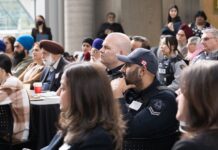Kwantlen Polytechnic University
A very powerful and productive gathering of the Sikh leadership, youth, police, community service agencies and academic experts marked two days of the residential summit that took place on the grounds of the RCMP training facility in Chilliwack on July 7-8. The presidents, board members and youth representatives of 10 gurdwaras and police officers of all the eight municipalities from across the Lower Mainland assembled to share, reflect, learn and create an action path to develop effective youth programs in their respective agencies.
A total of 26 participants from gurdwaras, including youth members, 19 police officers, two academic researchers, three community service representatives, and four undergraduate student assistants, worked as a collective. This summit was a repeat of the success of the 2013 summit which was a historic first.
It all began some four years ago with Staff-Sgt. Baltej Singh Dhillon taking the lead on behalf of the RCMP and reaching out to the collective of the Sikh leadership, the South Asian Community Coalition Against Youth Violence (SACCAYV), researchers of the Acting-Together-CURA project of KPU, and MOSAIC. Encouraged by the positive response and the full support of the offices of the RCMP Assistant Commissioner and the District Commander of the Lower Mainland, and the Combined Forces Special Enforcement Unit of BC (integrated anti-gang police agency), Dhillon pursued the path of collaborative action targeting prevention of senseless violence and recruitment of youth by criminal gangs.
Dhillon’s main goal has been to undertake a comprehensive and strategic action plan that would bring together the police and the community. The focus would be on the strengths, resources, and the willingness of the community leaders and academic knowledge experts as well as the front line service agency workers to become equal partners with the police.
While the police could have started with any community, the decision went in favor of the Sikh community as a starting point. There were several reasons.
- The Sikh community has historically demonstrated a strong collective.
- The Sikh gurdwaras are a hub of social connections and community service.
- The Sikh leadership has remained very proactive and resourceful in offering programs addressing social issues.
The key person to bring the Sikh leadership on board for this initiative was Balwant Sanghera, Chair of the SACCAYV, an organization which began in 2002 as the Sikh Societies of the Lower Mainland. This group has evolved into a strong network of the Sikh leadership, academic institutions such as the KPU and Langara, and various service agencies such as MOSAIC.

SO what did the summit accomplish?
Following up on the commitments of the 2013 Summit, a very systematic inventory of current youth programs offered in all 16 gurdwaras and eight police offices of the Lower Mainland was compiled and summarized by the research team of KPU’s AT-CURA project. From June 2014 to November 2014 separate meetings with the police chiefs, police officers and gurdwara leaders were held at the E Division RCMP headquarters in Surrey.
A very important step was then undertaken by the AT-CURA researchers, Dr. Roger Tweed and myself to examine the past research and provide a list of 20 criteria that would mark effective youth programs. It was determined to run a “pilot” at two Sikh temples which would develop and run eight-weekly sessions of youth programs aligning closely with the criteria provided. Surrey’s Gurdwara Dukh Niwaran Sahib and New Westminster’s Gurdwara Sukh Sagar came on board to work with researchers and their respective police agencies. Following each weekly session, a report was sent to the researchers who compiled a summary identifying the criteria of effective youth programs met by each session.
At the 2015 summit, these remarkable achievements were shared and the participating gurdwara members and police officers examined the best practice model for developing similar evidence-based programs in their respective agencies. In a workshop facilitated by Ninu Kang (MOSAIC) and Dhillon, the productive outcomes of the valuable work were evident.
The Summit provided a step forward: From discussions to action.
This is a step that provides ample grounds for commending the whole community, the police, the researchers, and most importantly, the youth who eagerly participated at the summit providing input to the shaping of the action plan.
Participating Gurdwaras:
* Mission Sikh Temple: 32086 Lougheed Highway, Mission
* Gurdwara Sahib Kalgidhar Darbar: 30640 Blueridge Drive, Abbotsford
* Gurdwara Dukh Nivaran Sahib: 15255-68th Avenue, Surrey
* Gurdwara Sahib Brookside: 8365 140th Street, Surrey
* Guru Nanak Sikh Temple: 7050 120th Street, Surrey
* Gurdwara Sukh Sagar: 347 Wood Street, New Westminster
* Gurdwara Nanak Niwas: 8600 #5 Road, Richmond
* Khalsa Diwan Society: 8000 Ross Street, Vancouver
* Akali Singh Sikh Temple: 1890 Skeena Street, Vancouver
* Gurdwara Khalsa Darbar: 7749 Prince Edward Street, Vancouver















